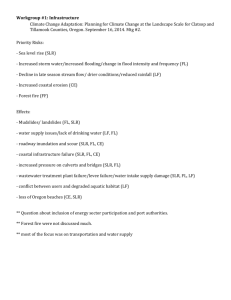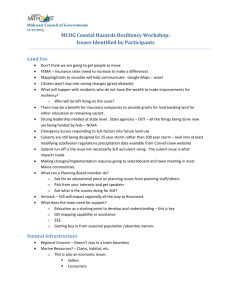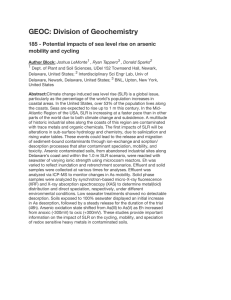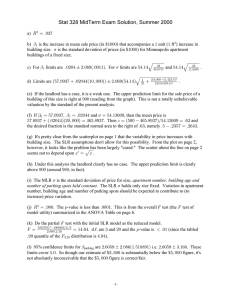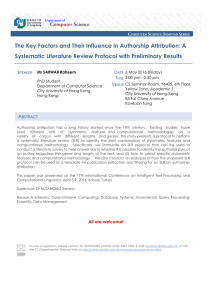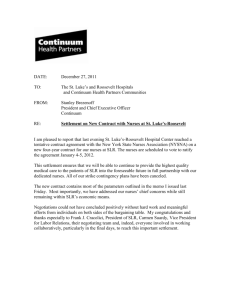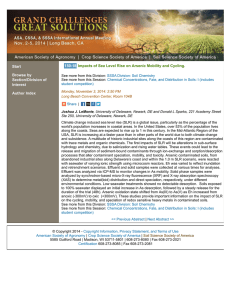Making SLR a better State Organization in Terms of ‘Accounting Profit/Loss’
advertisement
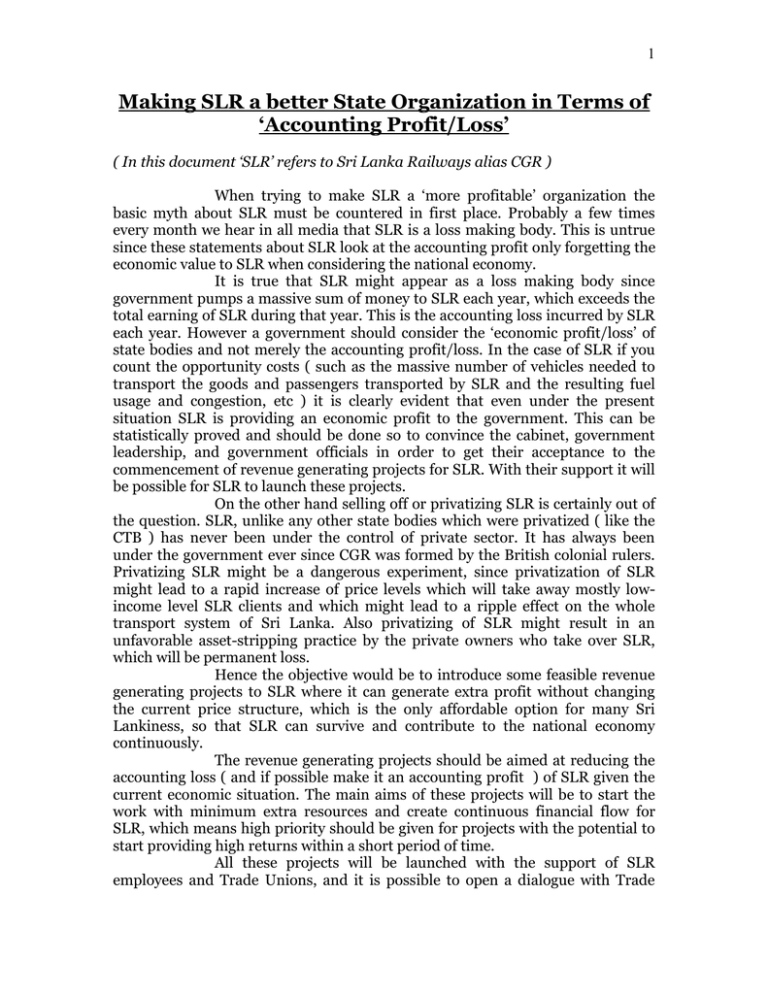
1 Making SLR a better State Organization in Terms of ‘Accounting Profit/Loss’ ( In this document ‘SLR’ refers to Sri Lanka Railways alias CGR ) When trying to make SLR a ‘more profitable’ organization the basic myth about SLR must be countered in first place. Probably a few times every month we hear in all media that SLR is a loss making body. This is untrue since these statements about SLR look at the accounting profit only forgetting the economic value to SLR when considering the national economy. It is true that SLR might appear as a loss making body since government pumps a massive sum of money to SLR each year, which exceeds the total earning of SLR during that year. This is the accounting loss incurred by SLR each year. However a government should consider the ‘economic profit/loss’ of state bodies and not merely the accounting profit/loss. In the case of SLR if you count the opportunity costs ( such as the massive number of vehicles needed to transport the goods and passengers transported by SLR and the resulting fuel usage and congestion, etc ) it is clearly evident that even under the present situation SLR is providing an economic profit to the government. This can be statistically proved and should be done so to convince the cabinet, government leadership, and government officials in order to get their acceptance to the commencement of revenue generating projects for SLR. With their support it will be possible for SLR to launch these projects. On the other hand selling off or privatizing SLR is certainly out of the question. SLR, unlike any other state bodies which were privatized ( like the CTB ) has never been under the control of private sector. It has always been under the government ever since CGR was formed by the British colonial rulers. Privatizing SLR might be a dangerous experiment, since privatization of SLR might lead to a rapid increase of price levels which will take away mostly lowincome level SLR clients and which might lead to a ripple effect on the whole transport system of Sri Lanka. Also privatizing of SLR might result in an unfavorable asset-stripping practice by the private owners who take over SLR, which will be permanent loss. Hence the objective would be to introduce some feasible revenue generating projects to SLR where it can generate extra profit without changing the current price structure, which is the only affordable option for many Sri Lankiness, so that SLR can survive and contribute to the national economy continuously. The revenue generating projects should be aimed at reducing the accounting loss ( and if possible make it an accounting profit ) of SLR given the current economic situation. The main aims of these projects will be to start the work with minimum extra resources and create continuous financial flow for SLR, which means high priority should be given for projects with the potential to start providing high returns within a short period of time. All these projects will be launched with the support of SLR employees and Trade Unions, and it is possible to open a dialogue with Trade 2 Unions in order to explain the importance of these projects and ill-effect of not going on with these projects. This can be and should be done in detail discussions with TU leaders and other employee representatives. Some of the projects of interest are listed below ( We can elaborate on how to plan, implement, conduct and enhance each of these projects in detail if necessary with details on how to evaluate the project as well, but we avoid going into such detail at this moment since it will make this document too long ) :1. Come to an agreement with institutions which use SLR resources ( especially state sector organizations such as Petroleum Corporation ) on the charges applicable for the SLR resources used by them. Similarly if SLR uses any resources of those organizations it can also be considered and a collective agreement should be reached on how much funds should be received by or paid by SLR and how frequently are they going to be settled and the modes of settling them from now onwards. By this way SLR can largely increase its income by updating its fees charged from these organizations to match up with current market values. 2. Market all the available spaces within land and properties of SLR within city limits of main cities and other possible areas to be rented for advertising. Proper agreements can be reached to earn the maximum price possible to be charged for these advertising slots based on current competitive market prices. This can generate a potentially high continuous for SLR income at a very low cost incurred to SLR. 3. Re-organize the SLR yards in order to save some space adjoining to city areas in main cities. By this way the land which is very valuable can be used to start some joint ventures with some other organizations ( private or state ) to generate additional revenue to SLR ( e.g.:- small shopping outlets, small cafeterias, public vehicle parks, where the land owned by SLR and the business co-owned by SLR or run by an organization which has come to an agreement with SLR either to share profit or pay fixed rental ) 4. Do a survey on all SLR equipment, which are outdated and carry out an auction and generate some cash by selling of these disposable equipment. Things which are of sentimental value and things which can be useful for any operational work of SLR further should not be sold ( since those goods are not disposables ). By selling off these disposable items SLR can create free space, which can be used for some revenue generating projects and also get rid of potential health hazards and social hazards by keeping unused equipment piled at SLR yards and other property owned by SLR. 5. Rent out spaces in SLR main Railway stations to various shop owners who do business in stations on proper agreements at revised rates on par with current market rates. And the agreements should include issues on payments to SLR, 3 measures to ensure quality of goods ( so that it does not tarnish image of SLR ) and a mutually agreed code of conduct which binds SLR and the merchant. This agreement system should be extended to small-scale merchants who do business in trains as well. Upon coming into retail sale agreements with SLR these merchants can be issued with proper identification cards so that it can get rid of thieves and burglars who pose as merchants in trains and railway stations. This will increase revenue of SLR and will make it easier to catch thieves, burglars and will contribute to the goodwill of SLR as a safer transport mode. 6. Collaborate with some supermarket chains to open up a few of their supermarket outlets in some of the main railway stations. This will prompt more people to come to railway stations and do transport via train. On the other hand SLR can generate extra income by offering the space for these supermarket chains within railway stations at competitive market prices. 7. Come into agreements with paddy, vegetable other goods transporters ( wholesale ) to use SLR as an interim medium to transport their goods. By coming into agreements with these wholesale transporters SLR can provide long distance transport at a very lower cost than using a fleet of lorries. By doing so wholesale transporters will save money and SLR can charge a competitive sum, which will still be attractive to wholesale transporters. By that way the goods transporters need lorries for a very limited distance ( from their own yard to main station in rural area and from destination station to their storage house ). SLR can arrange special trains with additional carriages for goods transport. SLR can increase its income by this way and it will be profitable. 8. Start a joint venture or lease out SLR property to a private freight forwarding companies ( who operate successfully all over the world ) and allow them to lay extra freight tracks on BOOT basis. By this way these freight forwarding companies will operate on a profitable goods transport line ( probably they may build some lines along existing lines exclusively for goods transport which are coowned by SLR ), and SLR will receive lease payments, profit sharing or both on these operations. Since these lines are used for goods transport effectively it will also reduce the congestion on main passenger transport lines and will allow SLR to utilize more passenger trains on time which will increase the goodwill of SLR and which will enable to launch passenger oriented revenue generating projects such as value added services for passengers in mid term and long term. NOTE : For all this to happen it is essential to have a good steering committee which consists of SLR employees, government representatives, private sector organization representatives who work with SLR projects, SLR commuter/client representatives and some external/internal consultants who also have genuine interest to develop SLR. They can work closely with SLR employees who are appointed for this work in order to achieve the desired targets. And all the people who take part in such revenue generating projects must be given performance based incentives ( a percentage out of the annual gross/net profit of a project should be allocated to people who directly 4 contribute to the project – this money can be distributed in a two tier system– a portion will be equally divided among all SLR employees and the other portion will be divided among resource personnel of projects based on the weight of contribution to the project ). This will be essential because unless we adopt such a benefit system it is likely for these people to be lured into unfavorable deals for SLR by external influence, given the socio-economic realities in Sri Lanka. D.K. Wimalasuriya H. Waidyarathna
